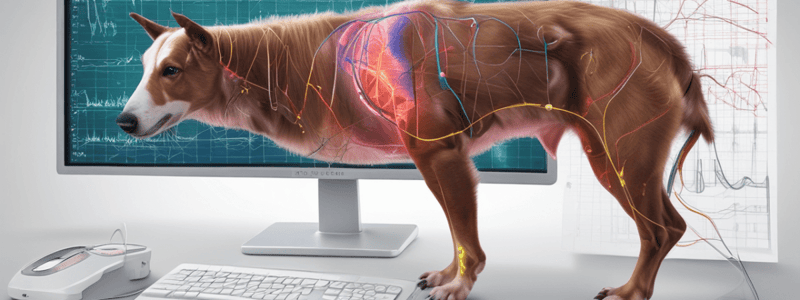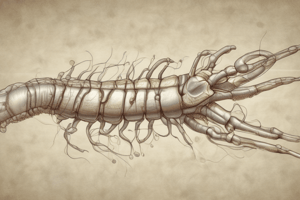Podcast
Questions and Answers
What is the primary function of the ECG machine?
What is the primary function of the ECG machine?
- To record a graphical record of electric potentials generated by the heart muscle
- To amplify the potentials detected on the surface of the body (correct)
- To characterize arrhythmias and conduction disturbances
- To display the ECG on a special graph paper in voltage and time
What is the main difference between a Computer/Portable ECG and an Ambulatory ECG (Holter monitor)?
What is the main difference between a Computer/Portable ECG and an Ambulatory ECG (Holter monitor)?
- Computer/Portable ECG can characterize arrhythmias, while Ambulatory ECG cannot
- Computer/Portable ECG records a short period, while Ambulatory ECG records continuously for 24-72 hours (correct)
- Computer/Portable ECG is used in hospitals, while Ambulatory ECG is used in veterinary clinics
- Computer/Portable ECG uses electrodes attached to the limbs, while Ambulatory ECG uses multiple leads
What is the purpose of an Event monitor?
What is the purpose of an Event monitor?
- To record only 1 or 2 leads when the patient triggers it during clinical signs (correct)
- To display the ECG on a special graph paper in voltage and time
- To record a graphical record of electric potentials generated by the heart muscle
- To characterize arrhythmias and conduction disturbances
What term is used to describe the movement of the waveform away from the baseline in either a positive or negative direction?
What term is used to describe the movement of the waveform away from the baseline in either a positive or negative direction?
What term is used to describe the line between waveforms?
What term is used to describe the line between waveforms?
What term is used to describe the normal cardiac rhythm where depolarization begins at the SA node?
What term is used to describe the normal cardiac rhythm where depolarization begins at the SA node?
What is the term used to describe an abnormal heart rhythm?
What is the term used to describe an abnormal heart rhythm?
What is the term used to describe an increase in heart rate?
What is the term used to describe an increase in heart rate?
What is the term used to describe a decrease in heart rate?
What is the term used to describe a decrease in heart rate?
What does the vertical axis in an ECG represent?
What does the vertical axis in an ECG represent?
What does a wider complex on the ECG indicate?
What does a wider complex on the ECG indicate?
What does the P wave represent in an ECG tracing?
What does the P wave represent in an ECG tracing?
How is left atrial and ventricular enlargement denoted on an ECG?
How is left atrial and ventricular enlargement denoted on an ECG?
In small animals, at what paper speed is ECG conventionally recorded?
In small animals, at what paper speed is ECG conventionally recorded?
What determines if the paper speed for ECG can be 25 mm/sec in small animals?
What determines if the paper speed for ECG can be 25 mm/sec in small animals?
What is the sum of all the electrical currents generated by the heart called?
What is the sum of all the electrical currents generated by the heart called?
What is the direction of the cardiac vector perpendicular to?
What is the direction of the cardiac vector perpendicular to?
What is the purpose of the Einthoven's triangle?
What is the purpose of the Einthoven's triangle?
What does depolarization refer to in the context of cardiac electrophysiology?
What does depolarization refer to in the context of cardiac electrophysiology?
What follows depolarization during an action potential in excitable cells?
What follows depolarization during an action potential in excitable cells?
What determines when the next action potential can occur in cells?
What determines when the next action potential can occur in cells?
How are changes in the amplitude, frequency, or shape of signals described in electrophysiology?
How are changes in the amplitude, frequency, or shape of signals described in electrophysiology?
Study Notes
ECG Terminology
- Heart Rate: number of heartbeats per minute
- Waveform: movement away from the baseline in either a positive or negative direction
- Segment: a line between waveforms
- Interval: a waveform and a segment
- Complex: several waveforms
- Tachycardia: increase in heart rate
- Bradycardia: decrease in heart rate
- Sinus Rhythm: normal cardiac rhythm where depolarization begins at the SA node
- Arrhythmia: abnormal heart rhythm
How ECG Works
- When cardiac impulses pass through the heart, the electrical current spreads into adjacent tissues
- Electrodes can record the APs (action potentials)
- A dipole (positive and negative charge separated by a small distance) can generate local current flow and a small electrical field
- Standard calibration paper speed is 25 mm/sec in humans, 50 mm/sec in small animals
- The horizontal axis represents time in milliseconds
- The vertical axis represents amplitude in millivolts
ECG Components
- Each component of an ECG tracing reflects an electrical event occurring in a specific part of the heart
- The sequence of electrical events follows specific anatomic pathways within the heart
- In health, these events are precise and consistent
- ECG evaluation includes determination of heart rate, heart rhythm, and waveform morphology (amplitude and duration)
ECG Waves and Intervals
- P Wave: represents depolarization of atrial muscle
- QRS Complex: represents ventricular depolarization
- T Wave: represents ventricular repolarization
- PR Interval: represents the time between P wave and QRS complex
- QT Interval: represents the time between QRS complex and T wave
ECG Leads
- Einthoven's Triangle: electrodes are placed in the 2 arms (RA, LA) and 1 leg (LL)
- Lead I: records voltage between LA and RA
- Lead II: records voltage between LL and RA
- Lead III: records voltage between LL and LA
- Standard bipolar leads (I, II, and III) provide information on the frontal plane of the heart
ECG Types
- In-hospital ECG: computer, portable, Alivecor Vet monitor, KardiaMobile
- Ambulatory ECG (Holter monitor): records continuously for 24, 48, or 72 hours on multiple leads simultaneously
- Event monitors: external event monitor and implantable event monitor (implanted subcutaneously)
- Veterinarian Dr. Vieira's lecture goals:
- Know the major indications for an ECG
- Understand ECG terminology
- List the ECG waves and describe their significance
- List the most important segments/intervals and their significance
ECG History
- Willem Einthoven introduced the term "electrocardiogram" in 1893
- Einthoven proposed the placement of electrodes for ECG recording, which is now known as Einthoven's Triangle
Studying That Suits You
Use AI to generate personalized quizzes and flashcards to suit your learning preferences.
Description
physio 1




